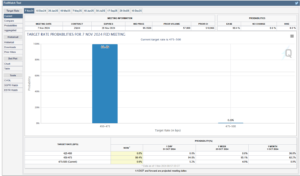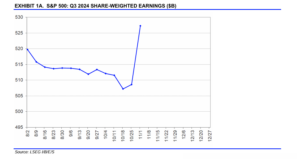Above is the CME’s Fedwatch, cut-and-pasted this morning after the October non-farm payroll report, showing a 99.4% probability of a 25 basis point rate cut next Thursday, November 7th, 2024.
The mega-cap tech earnings are mostly done, except Nvidia, the core PCE and GDP were released this past week, the October non-farm payroll report was released this past week, and if all that couldn’t dissuade any movement in fed funds futures, nothing will.
This LSEG “This Week in Earnings” chart was always fascinating, and I never took the time to study it, but it’s essentially a “net income” chart for the SP 500. What it shows is the influence of the mega-cap names on the SP 500.
Note the spike this week as Alphabet, Microsoft, Apple, and Amazon reported.
Readers have seen this s/sheet table just above before: it shows the weekly change in “expected” SP 500 EPS and revenue growth rates for trhe current quarter as well as through early ’26.
Note the improvement this week in the expected Q3 ’24 SP 500 EPS growth rate: it jumped from an expected +4.4% last week to a current +8.4% as of Friday, November 1.
The four sectors that have seen the sharpest growth improvement in growth rates since October 1 are:
- Consumer Discretionary, from +2.4% to 10.9%;
- Financials, from +2.1% to +9.1%;
- Info Tech, from +15.4% to +19.1%
- Communication Services, from +12.3% to +24.1%;
Note how Communication Services expected EPS growth has doubled from +12.3% to +24.1%.
As of 10/31/24, and per Bespoke data, the XLF or the Financial Sector SPDR Fund was +26.77% YTD, almost 700 bp’s better than technology and only exceeded by Communication Services +28.85% YTD return.
Summary / conclusion:
There’s a lot of chatter in financial media on the move in the 10-year and 30-year Treasury yields in the month of October ’24, but almost no one talks about the impact of the inverted yield curve on the financial system. The Fed will likely do two more 25 bp’s fed funds rate cuts before the end of 2024.
On Thursday night, after the FOMC announcement, the midpoint of the “expected” fed funds range of 4.50% to 4.75%, will be 4.625%. That will still likely leave the yield curve slightly inverted, with the 10year yield likely below the fed funds rate, but by December ’24, investors will likely see a fed funds rate at 4.375%, so investors might not see a true normal slope to the yield curve until 2025.
The 2’s – 10’s spread (i.e. the 10-year Treasury yield minus the 2-year Treasury yield) has been positive since late August ’24 or about 8 weeks, and per my internal spreadsheet that 2’s – 10’s spread first turned negative, and has stayed negative, since July 8 ’22.
Perhaps I’m overstating it’s importance, but I suspect the Fed wants the Treasury yield curve to return to a normal slope.
With a full weekend of writing still ahead, the weekly SP 500 earnings update is being kept short and sweet.
The technology sector (Apple and Microsoft), the consumer discretionary sector (Amazon and Tesla) and the communications sector (Alphabet and META) mostly passed with flying colors this week in terms of earnings. Microsoft was a little light in guidance, about $1 billion for a fiscal Q2 ’25 quarter expected to generate $69 billion in revenue, but the software giant did lower numbers.
Friday night, 11/1/24, after the market close, it was announced that Nvidia would be joining the Dow 30, and that Intel would be kicked out of the old world index. Per one source, and it can’t be recalled, only about 2% of the world’s global investable assets, is benchmarked against the Dow 30. Ryan Detrick, who is a solid technical analyst, whom I was reading when he was still at Schaeffer’s Investment Research out of Cincinnati, (now at Carson Group) always noted that being ejected from the Dow 30 was typically a good sign that all the bad news was probably in that stock. Ryan would know better than I, but there is a history of Dow rejects performing quite well after being tossed out of Dana’s (I mean the Dow 30).
None of this is a recommendation or advice, but only an opinion. Past performance is no guarantee of future results. Investing can and does involve the loss of principal, even for short periods of time. Information on this blog may or may not be updated, and if updated may not be done in a timely fashion.
Thanks for reading



